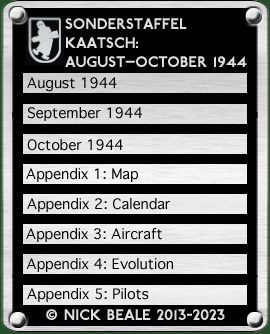Kaatsch’s orders for battle reconnaissance were to come direct from Nineteenth Army but the Staffel appears not to have flown on this date. The same arrangements were to apply on the 18th as well. In its new operational area, 5.(F)/123 put up four sorties over Allied forward areas on the Belgian-Dutch border, reporting a Bf 109 damaged by Thunderbolts at 16.20 hrs. An hour later, the Staffel’s Oblt. Kaiser reported a strength of 10 (7) pilots and 8 (1) aircraft. The unserviceable machines were: Werk Nummern 15220, 110520, 110553, 110554, 110557, 760005, 780692 and. 412169. Even so, on the 18th Kaiser told FAG 123 that the “Mommenheim detachment” had yet to transfer as no lorries had arrived there thus far.
Jagdgruppe 200 told «Aufklärungsstaffel K» in Freiburg that Hauptfw. Huppenkothen and Uffz. Ordon were urgently needed in Bierstadt since JGr. 200 was being disbanded and they had to wind up the Staffel’s affairs.
The Staffel had a reported strength of 9 x Bf 109 G-6.
On the 21st, Luftflotte 3 set out its intention that after restoring serviceability, 2./NAG 13 would transfer to Freiburg. Once it arrived, FAG 123 was to withdraw Staffel Kaatsch from operations and disband it. Next day, Jagdgruppe 200 told Ltn. Moschke in Freiburg that the Gruppe’s Fw. Pofer should be dispatched immediately to JG 2 in Nidda (about 50 km. north east of Frankfurt). Hoping to get back a vehicle it had loaned, the Gruppe also inquired as to the whereabouts of Transport Column 153/XII, formerly working under Flughafenbereich Salon in Southern France. A “visual survey” of the Briançon area (around 80 km SE Grenoble) was flown from Italy, probably by NAGr. 11. The Sonderstaffel dispatched two Rotten on visual reconnaissance on 22 September. Over 300 vehicles were seen around Besançon and 15 Austers on the airfield there. Also noted were a major new signals installation and, explosions round the bridge at L'Isle-sur-le-Doubs. There were about another 125 vehicles round Vesoul and the Staffel’s former base at Luxeuil was undamaged and fully useable. The north east of there were 50 heavy tanks and 20 armoured personnel carriers. In Luxeuil itself a field hospital had been established. On the 23rd, a Lt. Viemann of JG 200 asked Kaatsch as a matter of urgency when the Staffel would be replaced by 2./NAG 13 and when remaining elements of the Jagdgruppe could be withdrawn and disbanded. The same day, the Luftwaffe in Italy signalled 157. Reserve Division that “P/R of the passes has been ordered in accordance with your communication of 15/9 and 20/9. It will be carried out when weather is suitable”. On the 21st Moschke had flown an operational sortie in "7" from 13.30–13.40 hrs. The brief duration of this flight and the fact that he flew an even shorter test flight in the same machine on the 23rd, suggests that he had encountered a technical problem.
Two Rotten had been active “in the southern battle area” over the Épinal – Luxeuil region but both were forced to break off prematurely in the face of powerful fighter defences, losing one of their number. Lieutenants Ronald M. Faison and William C. Waller of the 87th FS/79th FG each claimed a Bf 109 in the Mulhouse area. Heinz Moschke had taken off from Freiburg in “2”, to be shot down after only 30 minutes in the air. He may well have been wounded because on 18 October he died of a "heart weakness" in hospital at Marienbad (Marianske Lazne, Czech Republic), just short of his 21st birthday. His service had won him the EK I, awarded by Genltn. Alexander Holle who assumed command of Luftwaffenkommando West on 25 September.
The Heeresgruppe requests that the Remich bridgehead [Luxembourg] be maintained for the time being … it is currently essential as a jumping-off point for 1st Army’s reconnaissance in view of the inadequate aerial reconnaissance. Army Group G to Ob. West (25 September 1944) Jagdgruppe 200 notified Kaatsch that it (i.e. JGr. 200) was being disbanded in accordance OKL General Quartiermeister’s order Nr. 13012. For the Staffel this would mean that “released personnel” were to stay in Freiburg and await transfer orders. Vehicles were to be handed over to other units. The same day, 1./NAG 13 sent a message to say it was not carrying out reconnaissance westward of Belfort “owing to the great distance” [about 215 km. from its base at Lachen-Speyerdorf to Belfort]. The 2./NAG 13 had not yet been brought up so the unidentified addressee was advised to approach Staffel Kaatsch instead. On the 25th, Luftwaffenkommando West issued an appreciation of the reconnaissance situation in its area, noting that: Carrying out of operations greatly hindered by the bad aircraft position, due to losses in the last few days. the 6 Me 109 allocated on 23 September have not yet arrived. Four of these aircraft could in any case only be employed for auxiliary purposes, as the vertically-mounted [Rb 12.5/] 7 x 9 are only suitable to a limited extent for the present continual photo-reconnaissances. Allocation of Me 109 [with] MW 50 and [Rb] 20/30 and or /50 urgently necessary. On the 26 Freiburg reported on the miscellany of aircraft currently stationed there. Among these were 11 "Bf 109 - H" which must have included Staffel Kaatsch's aircraft. The meaning of the H is obscure (the unit never reported possessing any of the extremely rare H sub-type) unless someone was using the old term for tactical reconnaissance machines (Heeresaufklärer). The following day, 4.(F)/123 was ordered to move from Reims to Charleville in Belgium. continued on next page …
|
|||||||||

TIMELINE |
|
19 September |
US troops liberate Nancy. |
